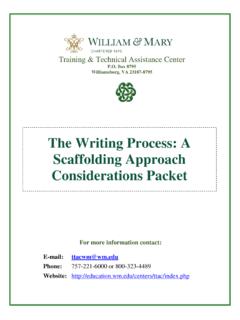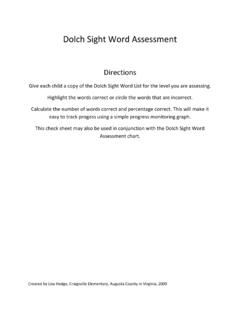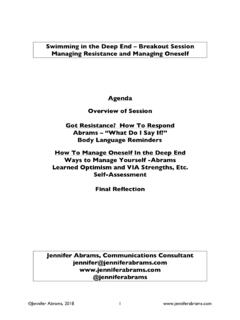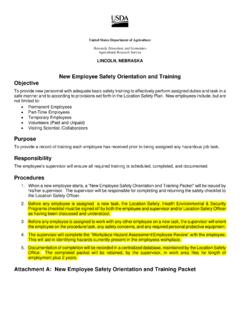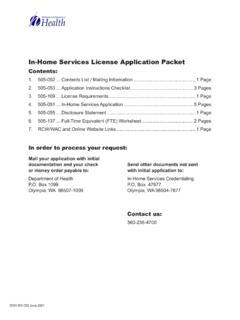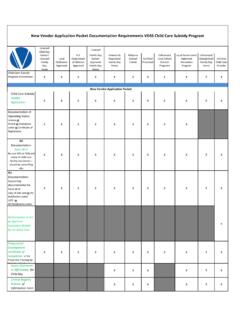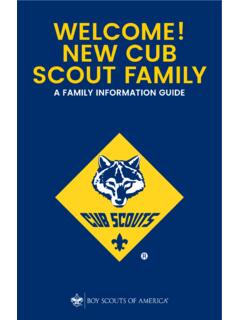Transcription of Geometry Strategies for Middle School - College of William ...
1 Training & Technical Assistance Center Box 8795 Williamsburg, VA 23187-8795 Geometry Strategies for Middle School Considerations packet For more information contact: E-mail: Phone: 757-221-6000 or 800-323-4489 Website: Considerations: Geometry Strategies for Middle School T/TAC W&M 2004 2 Geometry Strategies for Middle School This Considerations packet describes Strategies Middle School mathematics teachers can incorporate into their teaching of Geometry . An overview of the van Hiele Model is followed by a description of how to assess students level. Strategies for teaching plane figures, perimeter and area, geometric solids, and transformations are also included. The van Hiele Levels During the Middle School years, most students are making the transition from inductive methods of reasoning (conclusions based on several past observations) to a more formal method of deductive reasoning (proving statements from accepted postulates, definitions, theorems and given information) (National Council of Teachers of Mathematics, 2000).
2 However, students at this age may be functioning at many different levels of reasoning ability. Therefore, before beginning instruction, it is important to assess students reasoning level. This allows teachers to differentiate instruction based on student readiness. There are five developmental levels of geometric reasoning based on a study by Dina van Hiele-Geldof and her husband, Pierre Marie van Hiele. They are: Level 0 (Basic Level): Visualization At this level students view objects as entire entities, not noticing individual components or properties. The focus is on the whole object, not its parts. Level 1: Analysis Students begin to recognize that geometric shapes have parts and special properties. However, they are not able to describe how these properties are related, nor are they able to understand definitions. Level 2: Informal Deduction At this level students comprehend the connection between properties within geometric figures and from one set of figures to another.
3 Students are able to follow proofs, but are not able to construct one themselves. Level 3: Deduction At this level students can construct a geometric proof and understand the connection between postulates, theorems, and undefined terms. Level 4: Rigor At this level students see Geometry in the abstract. Students can move between different geometric systems and can compare and contrast them (Crowley, 1987). A number of assumptions are basic to the van Hiele model. Students levels are not affected by their age. Students must master each developmental level to progress in their geometric understanding. Level is determined by concepts that have been taught to the students. At the Middle School level it is of utmost importance that teachers begin to prepare students for the more formal study of Geometry to follow in high School . Most high School courses are taught with the Considerations: Geometry Strategies for Middle School T/TAC W&M 2004 3 understanding that students are reasoning at level 3 or 4.
4 Therefore, it is the responsibility of the Middle School teacher to move students in that direction (NCTM, 2000). In order for teachers to identify the developmental level or geometric reasoning of each of their students, assessment is required. The following activity serves as a tool to determine each student s geometric reasoning level, which will subsequently inform instruction. Using the draw feature in a word processing program, create a handout that consists of at least 20 triangles of varying sizes and classifications. For example: Have students sort the triangles into as many sets as possible. Then ask students to write a paragraph describing why they placed each triangle into a given set. Using this information, the teacher should be able to determine students developmental level based on the following divisions: Level 0: Students divide the triangles into sets based on size ( , small, medium, and large).
5 Level 1: Students divide the triangles according to one characteristic, most likely focusing on either the length of sides or the size of the angles. Level 2: Students observe more than one characteristic of the triangles. For example, they will see that there are isosceles right triangles and scalene right triangles, or that an isosceles triangle can be right, acute, or obtuse. Level 3: Students use definitions, postulates, or theorems to make connections and to reason. Level 4: Students grasp abstract concepts and apply them through more than one geometric system. Students at the Middle School level are usually moving towards level 3 with few to none having reached level 4 (NCTM, 2000). Once the developmental levels of the students in the class have been determined, the teacher is able to determine the students instructional level.
6 Students taught at their instructional level master skills necessary for them to progress in geometric reasoning. If a student is at one developmental level and the teacher instructs concepts at a different developmental level, it is very likely that the student will not grasp and retain the information (Crowley, 1987). Strategies to Teach Plane Figures The following Strategies have been used effectively to teach plane figures to Middle School students. Research has shown that when teachers incorporate these four Strategies in their instruction, retention is increased (Marzano, Pickering, & Pollock, 2001).These Strategies include: Manipulatives such as geo-strips or fasteners and tag board Cooperative learning using the jigsaw method Similarities and differences using Venn diagrams Considerations: Geometry Strategies for Middle School T/TAC W&M 2004 4 Vocabulary enhancement using a manipulative and group activity Manipulatives When parallelograms are first introduced to the class, it is helpful for the students to have a manipulative to explore.
7 Geo strips, which can be made of varying size strips of tag board and brat fasteners, help students discover the properties of parallelograms. Jigsaw Method Once students have been introduced to parallelograms and their basic properties, the jigsaw method may be used to further explore special types of quadrilaterals. Teachers can follow these steps: 1. Divide the class into groups of four. Within each group assign a student to be a rectangle, square, rhombus, or trapezoid. 2. The expert from each group will leave their home group and meet together with the experts from the other teams. For example, all the rectangles will meet in one corner, the rhombi in another, and so on. 3. Provide each group with a guided activity that will allow members to explore their shape and learn its properties. The group members must come to a consensus on the properties and feel confident that they can teach these properties to their home teams.
8 4. The expert group for each figure should prepare examples, diagrams, properties, and three quiz questions to share with their home teams. 5. After the allotted time, students return to their home teams to share their knowledge with their respective groups (Posamentier, Hartman, & Kaiser, 1998). Venn Diagrams As students further study the properties of different types of parallelograms, they need to learn how to compare and contrast the properties of these shapes. Venn diagrams are an excellent method for displaying the shared as well as unique properties of each type of parallelogram (Marzano et al., 2001). Venn Diagram Comparing Parallelograms Vocabulary Enhancement Finally, to reinforce new vocabulary explored in the unit, students can participate in a group game that focuses on the properties of each quadrilateral. The teacher can do the following: Rectangles Rhombus Squares Considerations: Geometry Strategies for Middle School T/TAC W&M 2004 5 1.
9 Divide the class into groups of four students. 2. Provide each group with a construction bag containing items such as straws, toothpicks, tiles to show right angles, and play dough. 3. Provide each student with a card that contains the description of one of the quadrilaterals studied. 4. Each student must use the items in the bag to construct the quadrilateral on his or her card, making it identifiable to others in his or her group. 5. Using their definitions, students must justify the construction of the figures (NCTM, 2000). Strategies to Teach Perimeter and Area Middle School students need concrete experiences with the concepts of perimeter and area as a foundation for future study of these topics in high School Geometry . Beginning with manipulatives, moving to pictures, and ending with the formulas enables students to comprehend the meaning of perimeter and area and the differences between the two (Malloy, 1999).
10 Teachers can use the following activities to help students gain a full understanding of these topics: Area and perimeter using manipulatives Index cards to show relationships between formulas Manipulatives As the van Hiele research indicates (Crowley, 1987), it is necessary to know students developmental levels in order to design appropriate instruction. When working with perimeter and area, the first experience students should have is solving problems to gain information (Malloy, 1999). Teachers should provide students the following: Definitions of perimeter and area, but not formulas Rectangles and squares on dot paper that can be used to determine the perimeter and area Triangles on dot paper to determine perimeter and area Irregular shapes such as those shown below to find perimeter and area Next, provide time for students to interact with the information.



